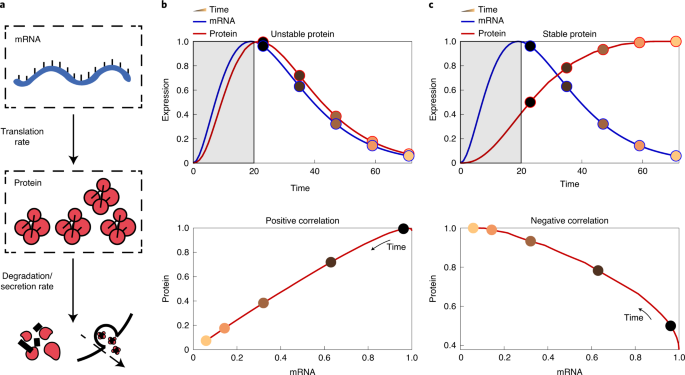a, Two simulated mRNA profiles representing typical profiles found in the data, one peaking at the villus bottom (black curve) and one peaking in the middle (green curve). b, Example of non-constant decay rate functions employed for the simulation of protein data. Generally, the decay rate switches from the villus bottom value to the villus top value over a period of 24 hours centered at the middle of the villus (48 hours). c, Distribution of mean relative standard errors of the protein measurements of 2,866 genes (for each gene, the standard error in protein expression was divided by the mean protein expression per zone and then the mean over all 6 zones was computed). d, Outline of the simulation procedure to obtain 16,000 synthetic mRNA–protein profiles. e, Results of model fitness evaluation (heatmaps) and parameter estimation (boxplots) on simulated data with non-constant decay rates. The color scale of the heatmaps indicates what fraction of simulated profiles for a given set of {mRNA type, lower villus half-life, upper villus half-life, noise (simulated relative standard error, denoted sim_RSE)} could be rejected by the constant-rate model (N=100 per tile). The box plots show the estimated half-lives for these estimation procedures when assuming the constant-rate model. Horizontal lines are medians, boxes delineate the 25–75 percentiles, whiskers extend to the most extreme data point within 1.5× the interquartile range (IQR) from the box. Green dashed line: mean of upper and lower villus half-lives; black dashed line: upper villus half-life. f, Violin plots showing bulk translation efficiency of enterocyte-specific genes stratified by the villus zone in which they peak. g, Translation efficiency curves used in the constant-rate (black curve) and declining-rate (green curve) models respectively. The declining-rate curve is derived from the medians of the data in f to which an exponentially decaying curve has been fit.
https://www.nature.com/articles/s42255-021-00504-6
Spatial discordances between mRNAs and proteins in the intestinal epithelium
